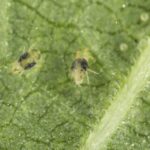Spider Mite
Leaf Feeding Insects & Mites
Spider mites are tiny, spider-like pests that feed on the sap of plants. They are members of the family Tetranychidae and are sometimes called red spider mites due to their red color. Spider mites are common pests in gardens and greenhouses, and they can cause significant damage to crops, ornamental plants, and trees.
Spider mites are very small, measuring only 1/50 to 1/100 of an inch in length. They have a flattened, oval body and eight legs. Their color can range from yellow to green to red. Some species of spider mites produce webs that look like fine, white cobwebs.
Spider mites feed by inserting their needle-like mouthparts into plant cells and sucking out the sap. This feeding causes the cells to collapse, leading to yellowing and browning of the leaves. In severe cases, the plant's growth may be stunted, and the plant may eventually die. Spider mites also produce a sticky substance called honeydew, which can attract ants and promote the growth of sooty mold.
Spider mites reproduce quickly and can build up large populations in a short amount of time. They are most active in hot, dry weather, which makes them a common problem in arid climates. However, spider mites can survive in a variety of environments, including greenhouses and indoor plants.
To control spider mites, it is important to identify the problem early and implement control measures before the population becomes too large. Cultural controls, such as watering the plants and keeping the environment humid, can help reduce spider mite populations. Chemical controls, such as insecticidal soaps or oils, can also be effective.
In conclusion, spider mites are tiny pests that can cause significant damage to plants. They are common in gardens and greenhouses, and can be controlled through cultural and chemical measures. Regular monitoring and early intervention are key to preventing serious damage from spider mites.



